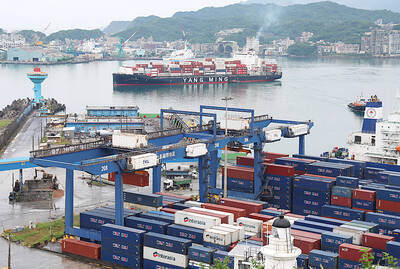Taiwan Semiconductor Manufacturing Co (TSMC, 台積電) yesterday said it was increasing its capital expenditure to about US$9 billion next year amid expectations that an improving global economy would stimulate electronics consumption and drive up chip demand.
The forecast capital spending for next year represents another record-high for the Hsinchu-based company. For this year, TSMC, the world’s biggest contract chipmaker, has budgeted US$8.3 billion for spending on new equipment.
Spending on research and development would expand to US$1.6 billion next year, up about 17 percent from US$1.37 billion this year, TSMC chairman and chief executive Morris Chang (張忠謀) said in a speech at the annual Supply Chain Management Forum in Hsinchu.
Chang said global GDP growth is forecast to improve to 2.6 percent, from this year’s estimated 2.4 percent expansion.
Benefiting from a better global economy, semiconductor revenue is expected to grow 3 percent next year, recovering from a projected 2 percent decline this year, he said.
TSMC would quicken its growth pace with revenue increasing by 15 to 20 percent year-on-year next year, from 19 percent this year, outpacing the semiconductor industry’s forecast growth of 3 percent and chip design industry’s 9 percent.
About one-third of TSMC’s revenue next year would come from 28-nanometer chips, Chang told investors in October.
His forecast largely matched Credit Suisse analyst Randy Abrams’ forecast that the company would expand its revenue by 18.72 percent to NT$654.43 billion next year from his estimate of NT$506.03 billion for this year.
Daiwa Capital Markets analyst Eric Chen (陳慧明) predicted a 12 percent annual increase next year.
“We have captured the opportunities that the third wave of killer applications [smartphones and tablets] represent to us,” Chang said, explaining why TSMC and its chip design clients were expected to recover quickly from the downturn.
He said a fundamental reason is the company’s creation of a “grand alliance,” which it has nurtured since its establishment. This alliance refers to its relationship and collaboration with materials and equipment suppliers, customers and intellectual property providers.
Qualcomm Inc and Nvidia Inc are among TSMC’s clients. The two have earlier complained that supply constraints for 28nm chips at TSMC was limiting their growth this year.
To cope with customers’ demand, TSMC would continue to ramp up 28nm production next year, Chang said, adding that he expected all lines to be running at full capacity throughout next year.
At present, TSMC can produce 68,000 12-inch wafers using 28nm process technology per month, he said.
He expected the company to fully catch up with customers’ demand this year, he added.
Commenting on the speculation that TSMC might build a plant in New York, Chang said the company was looking for a place to set up a factory.
“The US is one of the places under consideration,” Chang said. “But this has nothing to do with Apple.”
Apple Inc recently announced it was moving some production lines to the US.

CHIP RACE: Three years of overbroad export controls drove foreign competitors to pursue their own AI chips, and ‘cost US taxpayers billions of dollars,’ Nvidia said China has figured out the US strategy for allowing it to buy Nvidia Corp’s H200s and is rejecting the artificial intelligence (AI) chip in favor of domestically developed semiconductors, White House AI adviser David Sacks said, citing news reports. US President Donald Trump on Monday said that he would allow shipments of Nvidia’s H200 chips to China, part of an administration effort backed by Sacks to challenge Chinese tech champions such as Huawei Technologies Co (華為) by bringing US competition to their home market. On Friday, Sacks signaled that he was uncertain about whether that approach would work. “They’re rejecting our chips,” Sacks

Taiwan’s exports soared 56 percent year-on-year to an all-time high of US$64.05 billion last month, propelled by surging global demand for artificial intelligence (AI), high-performance computing and cloud service infrastructure, the Ministry of Finance said yesterday. Department of Statistics Director-General Beatrice Tsai (蔡美娜) called the figure an unexpected upside surprise, citing a wave of technology orders from overseas customers alongside the usual year-end shopping season for technology products. Growth is likely to remain strong this month, she said, projecting a 40 percent to 45 percent expansion on an annual basis. The outperformance could prompt the Directorate-General of Budget, Accounting and

NATIONAL SECURITY: Intel’s testing of ACM tools despite US government control ‘highlights egregious gaps in US technology protection policies,’ a former official said Chipmaker Intel Corp has tested chipmaking tools this year from a toolmaker with deep roots in China and two overseas units that were targeted by US sanctions, according to two sources with direct knowledge of the matter. Intel, which fended off calls for its CEO’s resignation from US President Donald Trump in August over his alleged ties to China, got the tools from ACM Research Inc, a Fremont, California-based producer of chipmaking equipment. Two of ACM’s units, based in Shanghai and South Korea, were among a number of firms barred last year from receiving US technology over claims they have

BARRIERS: Gudeng’s chairman said it was unlikely that the US could replicate Taiwan’s science parks in Arizona, given its strict immigration policies and cultural differences Gudeng Precision Industrial Co (家登), which supplies wafer pods to the world’s major semiconductor firms, yesterday said it is in no rush to set up production in the US due to high costs. The company supplies its customers through a warehouse in Arizona jointly operated by TSS Holdings Ltd (德鑫控股), a joint holding of Gudeng and 17 Taiwanese firms in the semiconductor supply chain, including specialty plastic compounds producer Nytex Composites Co (耐特) and automated material handling system supplier Symtek Automation Asia Co (迅得). While the company has long been exploring the feasibility of setting up production in the US to address